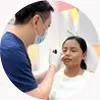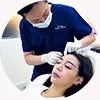
What is Cheek Filler?
Cheek filler is a non-invasive treatment used to restore volume and contour to the cheeks and mid-face area. They are made from hyaluronic acid, a naturally occurring substance that gives the skin volume and elasticity. As we age, our bodies produce lesser hyaluronic acid and collagen, resulting in wrinkles and sagging skin.
Fillers are injected into the skin at strategic points, providing volumisation that can last 12 – 18 months, depending on the type of filler used. With careful placement, they can also provide subtle definition to the cheeks, giving the face an overall lifted look, refreshed and youthful appearance.
Benefits of Cheek Filler
Cheek filler fill out hollowness and sunken cheeks, give the face a youthful and refreshed look.
Having a fuller cheeks can reduce the naso-labial fold or laugh lines because saggy cheeks contribute to deep laugh line and make you look older. Hence achieving a facelift effect and brigthen up the mid face.

Fast results
You will notice plumping up of cheeks and an improvement in the appearance with a youthful, sculpted look on the same day

Long-lasting
Last for 12 - 18 months, where as collagen stimulator filler such as Ellanse can last up to 3 years.

Safe and effective
The treatments are safe and effective, and there is minimal to no downtime associated with the treatment.
How Do Cheek Fillers Work?
When injected into the treatment areas of the cheeks, the filler plumps up the skin by adding volume and stimulating collagen production. This helps to smooth out fine lines, lift sagging skin, and create defined cheekbones.

Who Needs Cheek Filler Treatment?
- Restoring Volume Loss: Aging can lead to a loss of volume in the cheeks, resulting in a sunken or hollow appearance. Cheek fillers help restore this lost volume for a rejuvenated look
- Enhancing Facial Contours: Those who desire a defined and prominent cheekbones can use fillers to achieve facial contours and symmetry
- Correcting Asymmetry: People with uneven or asymmetrical cheeks can benefit from fillers to balance their facial features
- Boosting Self-Confidence: Those who are self-conscious about their facial appearance or who want to enhance their aesthetic appeal can use cheek fillers to enhance their overall look and confidence
Cheek Filler Treatment Process
The filler injection process typically involves several key steps:

Consultation
The process begins with a consultation to discuss your aesthetic goals.

Preparation
Treatment areas are cleaned, and a topical numbing cream may be applied.

Injection
Filler is then skillfully injected into the treatment areas using a fine needle.

Massaging
After the injections, the treated areas will be massaged gently to ensure an even distribution.

Post-treatment
Following the procedure, specific aftercare instructions are provided.
FAQ for Cheek Filler
How long do cheek fillers last?
HA filler typically lasts around 12 to 18 months. Collagen stimulator filler such as Ellanse can last longer up to 3 years.
How much does cheek fillers cost?
The cost of cheek fillers varies based on the type of filler and the quantity required. HA filler price range from $800-1000 per syringe and Ellanse M range from $1000-1500 per syringe.
Is it worth it to get Cheek filler in Singapore?
Many individuals find it worth the investment for enhancing facial volume and contour. It is a non-invasive way to maintain youthful look.
Who should not get cheek fillers?
People with allergies to filler ingredients, active skin infections, or certain medical conditions should avoid cheek fillers. Pregnant or breastfeeding individuals may need to postpone treatment.
What are the side effects and risks
While cheek fillers are generally safe, like any cosmetic procedure, they come with potential risks and side effects. Common side effects include swelling, bruising, redness, tenderness at the injection site.
